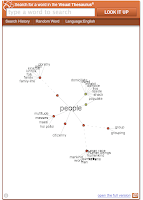"Vocabulary" is a term that can cause students to tune out immediately. My memories of vocabulary building in school involve worksheets, flashcards, and bold words with definitions at the end of the chapter. Most students fail to see the intrinsic value of new words, and building vocabulary becomes an exercise in failure for students and teachers alike.
Word Ahead Vocabulary Videos is a site that might be able to help. Opened to the public in January of 2009, the site features short videos with definitions, illustrations, and context for some six hundred words. You can use the widget above to see some examples of what the site offers.
Most of the videos seem to be aimed at high school-aged students, such as those trying to bone up for the SAT. (Click here for a complete word list.) Most videos are made by the folks at Word Ahead, though they also allow users to contribute by uploading their own videos.
Putting vocabulary words into videos will not make learning new words exciting for all students, but it might help, and it certainly beats worksheets. Word Ahead is a relatively new site, and thus should be expanding the ways teachers and students can interact with the videos. Stay tuned!
Words I Learned While Exploring Word Ahead:
Heterodoxy
Zoophagous
Lumen
Acidulous



















